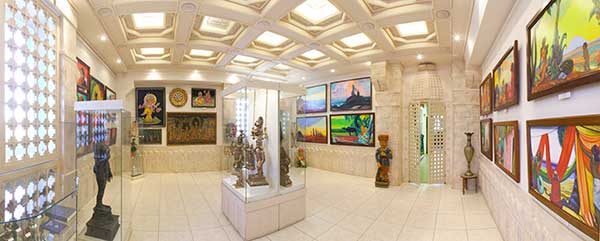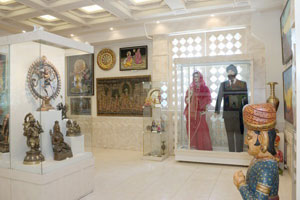Culture of India

India is one of the oldest cultural centers in the world, preserving the uniqueness of a centuries-old tradition. The legacy of Indian culture is multifaceted and immense. Its main achievements are presented in the hall of the permanent exhibition.
The moral foundations of society are captured, first of all, in the literary monuments ⎯ “Rigveda”, the epics of the “Mahabharata” and “Ramayana”. The art of India reached its peak in the 11th century in sculpture. The pinnacle of bronze casting was the image of Shiva Nataraja ⎯ Dancing Shiva. Gods in Hinduism are depicted both in the form of people and in the form of animals. The images of Durga and Lakshmi, Krishna and Hanuman reveal various aspects of Indian mythology. Indians attach particular importance to the elephant-headed God Ganesha, the son of Shiva and Parvati. The Indian Gods have wahans ⎯ mounts: the Ganesha’s mouse, Shiva’s bull, Parvati’s lion, Garuda’s Vishnu, Saraswati’s peacock. Peacock is considered a national bird. Metal statues of the gods ⎯ murti ⎯ presented at the exhibition.
In the 16th century, under the rule of the emperor Akbar, book miniature, combining Muslim and Indian artistic traditions, acquired particular importance. Heroic and historical plots became especially popular, telling about battles, campaigns, travels of Mughal rulers, as well as painting scenes of folk life. Miniatures can be viewed in a bookcase with books, including “Akbar-nama”. Important transformations have also occurred in architecture. Sculptural decorations gave way to a flat patterned ornament. The pearl of the architecture of this historical period is the Taj Mahal Mausoleum.
The history of the Indian people and their daily life is associated with arts and crafts. The exhibition presents such works as coinage, engraving, inlay, wood and stone carving. India is the birthplace of the finest muslin and brocade fabrics. A significant proportion of weaving is made up of sarees, the most popular garment that has become a symbol of Indian women. The first mention of sarees appeared in Hindu literature and art as early as 3000 BC. In the hall you can try on a saree.
Dolls in costumes of different peoples of India open another facet of this amazing country where people of different beliefs and people’s live side by side for centuries.

Not once the “Raduga” was visited by ambassadors of the Republic of India
